Competitive Tendering and Efficiency in a Dynamic Ugandan Environment
VerifiedAdded on 2019/12/18
|59
|22682
|401
Report
AI Summary
This report investigates the tendering process within Ugandan public-private partnerships, aiming to assess its competitive orientation. The study employs a qualitative research method, utilizing thematic analysis of secondary data from books, journals, and online sources, along with non-probabilistic sampling. The research explores the impact of external and internal factors on the competitiveness of tendering, examining how procurement processes add value to the public sector. Findings highlight the importance of cost coverage in bidding, currency conversions, and alternative costing strategies. The report concludes with recommendations for enhancing the competitiveness of the tendering process in Uganda. The study reveals that the tendering process is a crucial operation of public sector firms in developing countries like Uganda. It also examines how the government bodies invite bids for big projects with a bounded time limit for its acceptance. The study further reflects on the competitive positioning of tendering process in Ugandan entities operating in public private partnership.
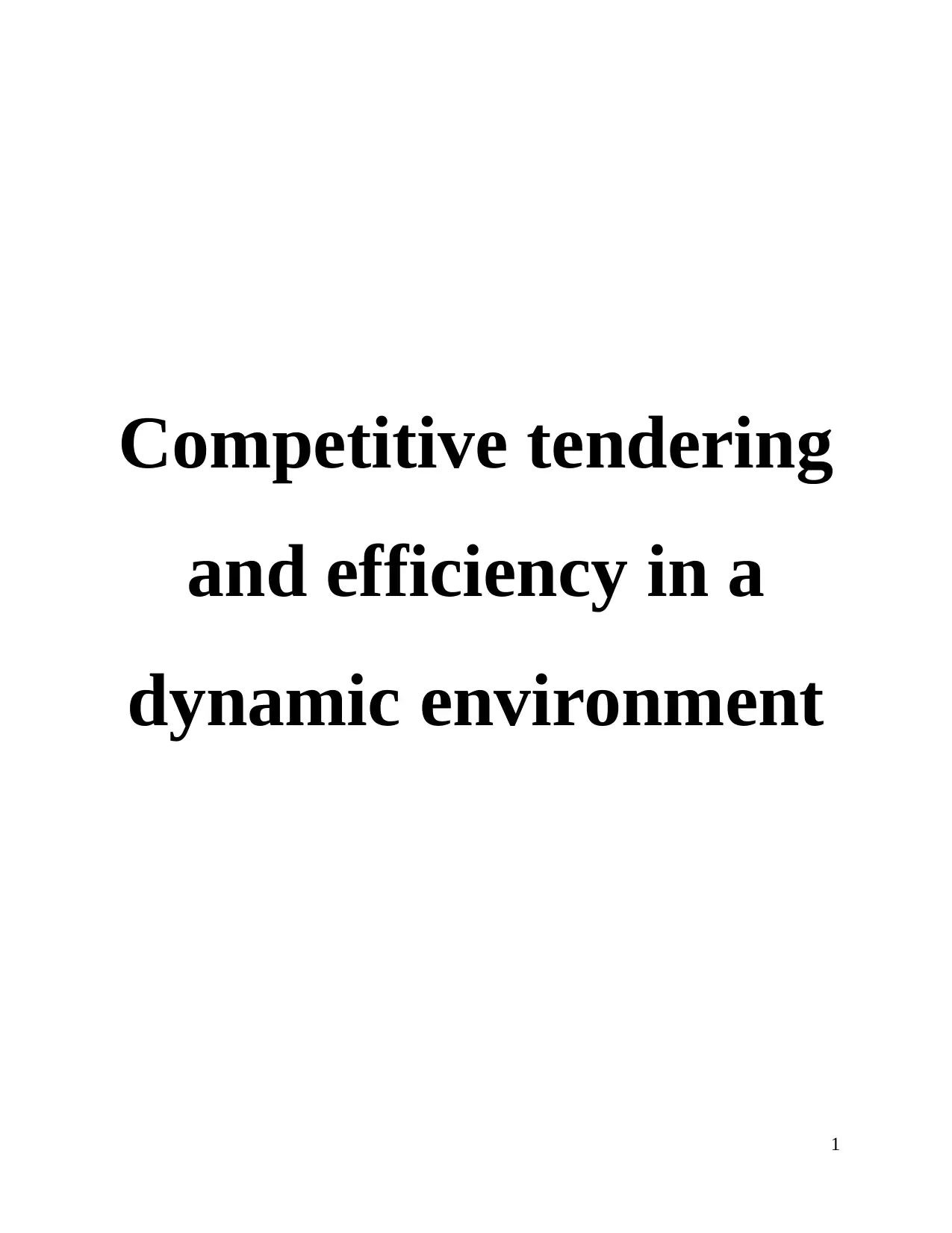
Competitive tendering
and efficiency in a
dynamic environment
1
and efficiency in a
dynamic environment
1
Paraphrase This Document
Need a fresh take? Get an instant paraphrase of this document with our AI Paraphraser
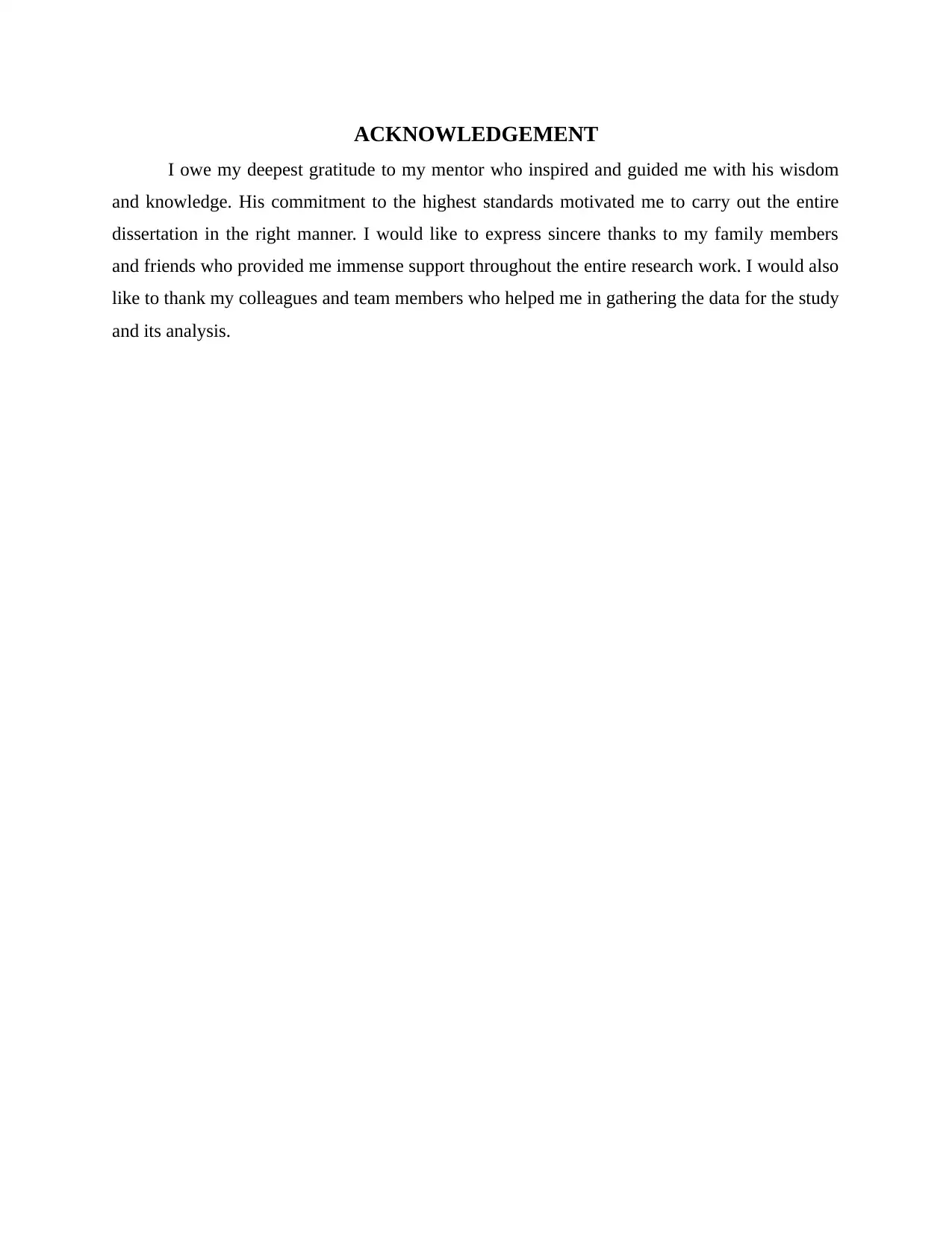
ACKNOWLEDGEMENT
I owe my deepest gratitude to my mentor who inspired and guided me with his wisdom
and knowledge. His commitment to the highest standards motivated me to carry out the entire
dissertation in the right manner. I would like to express sincere thanks to my family members
and friends who provided me immense support throughout the entire research work. I would also
like to thank my colleagues and team members who helped me in gathering the data for the study
and its analysis.
I owe my deepest gratitude to my mentor who inspired and guided me with his wisdom
and knowledge. His commitment to the highest standards motivated me to carry out the entire
dissertation in the right manner. I would like to express sincere thanks to my family members
and friends who provided me immense support throughout the entire research work. I would also
like to thank my colleagues and team members who helped me in gathering the data for the study
and its analysis.
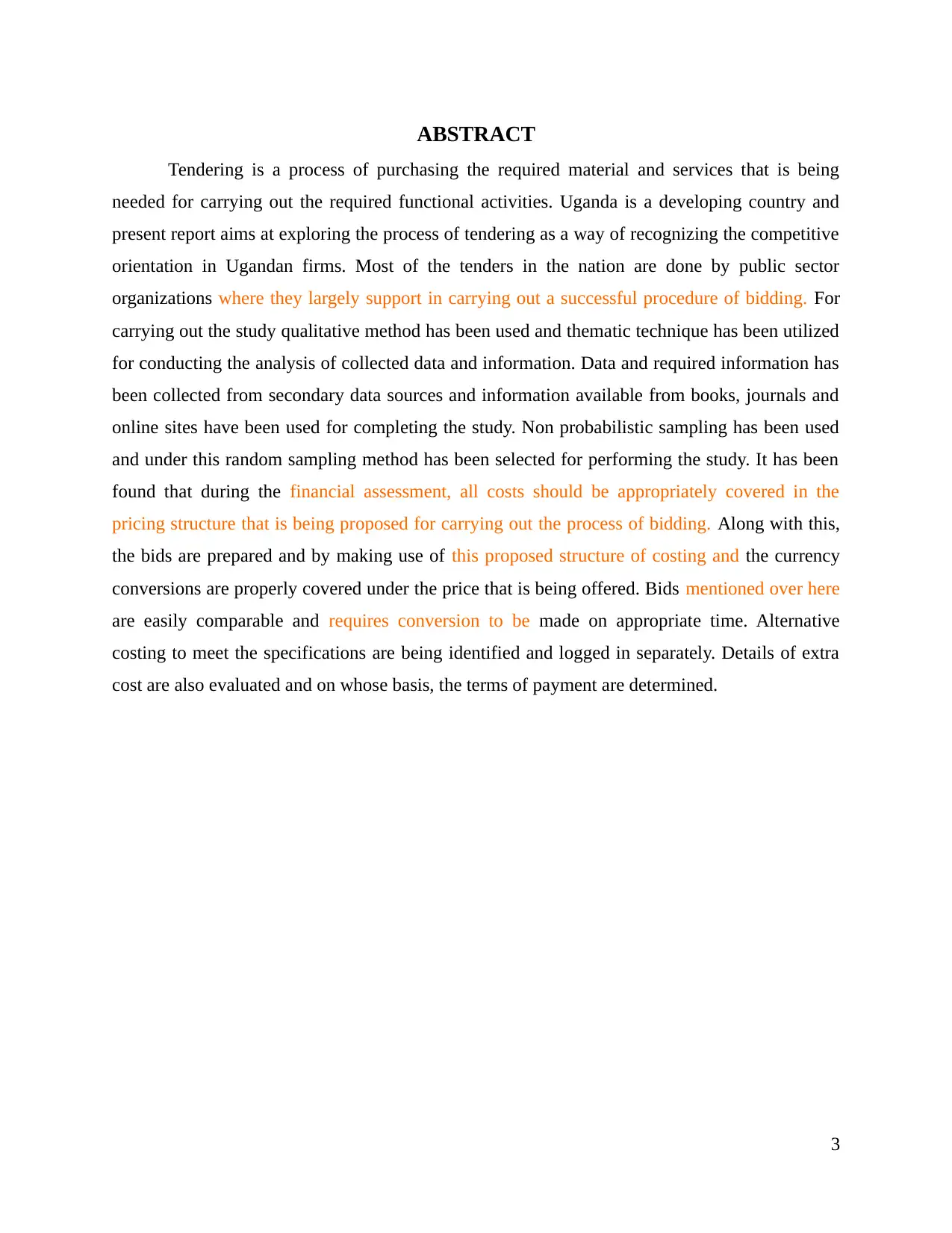
ABSTRACT
Tendering is a process of purchasing the required material and services that is being
needed for carrying out the required functional activities. Uganda is a developing country and
present report aims at exploring the process of tendering as a way of recognizing the competitive
orientation in Ugandan firms. Most of the tenders in the nation are done by public sector
organizations where they largely support in carrying out a successful procedure of bidding. For
carrying out the study qualitative method has been used and thematic technique has been utilized
for conducting the analysis of collected data and information. Data and required information has
been collected from secondary data sources and information available from books, journals and
online sites have been used for completing the study. Non probabilistic sampling has been used
and under this random sampling method has been selected for performing the study. It has been
found that during the financial assessment, all costs should be appropriately covered in the
pricing structure that is being proposed for carrying out the process of bidding. Along with this,
the bids are prepared and by making use of this proposed structure of costing and the currency
conversions are properly covered under the price that is being offered. Bids mentioned over here
are easily comparable and requires conversion to be made on appropriate time. Alternative
costing to meet the specifications are being identified and logged in separately. Details of extra
cost are also evaluated and on whose basis, the terms of payment are determined.
3
Tendering is a process of purchasing the required material and services that is being
needed for carrying out the required functional activities. Uganda is a developing country and
present report aims at exploring the process of tendering as a way of recognizing the competitive
orientation in Ugandan firms. Most of the tenders in the nation are done by public sector
organizations where they largely support in carrying out a successful procedure of bidding. For
carrying out the study qualitative method has been used and thematic technique has been utilized
for conducting the analysis of collected data and information. Data and required information has
been collected from secondary data sources and information available from books, journals and
online sites have been used for completing the study. Non probabilistic sampling has been used
and under this random sampling method has been selected for performing the study. It has been
found that during the financial assessment, all costs should be appropriately covered in the
pricing structure that is being proposed for carrying out the process of bidding. Along with this,
the bids are prepared and by making use of this proposed structure of costing and the currency
conversions are properly covered under the price that is being offered. Bids mentioned over here
are easily comparable and requires conversion to be made on appropriate time. Alternative
costing to meet the specifications are being identified and logged in separately. Details of extra
cost are also evaluated and on whose basis, the terms of payment are determined.
3
⊘ This is a preview!⊘
Do you want full access?
Subscribe today to unlock all pages.

Trusted by 1+ million students worldwide
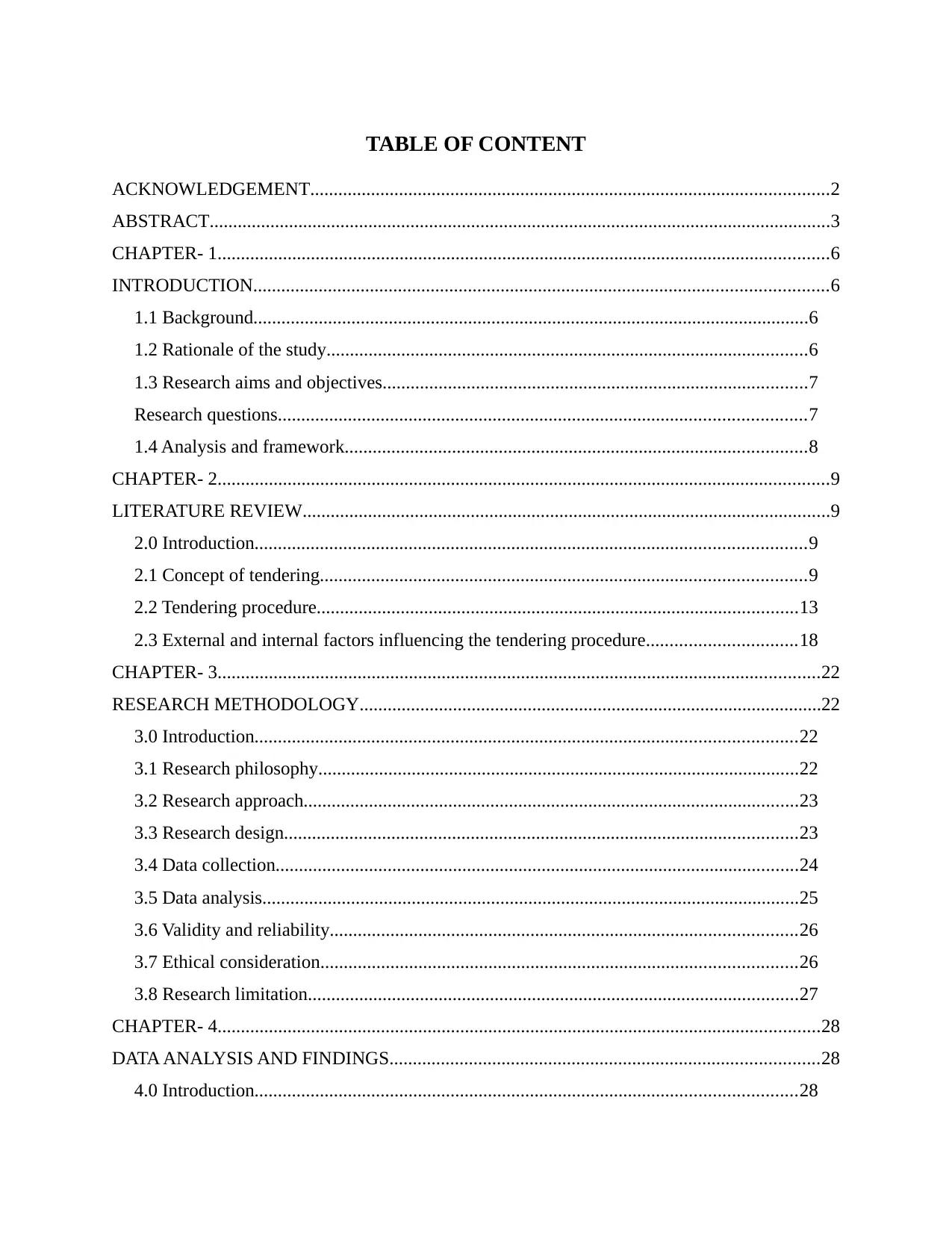
TABLE OF CONTENT
ACKNOWLEDGEMENT...............................................................................................................2
ABSTRACT.....................................................................................................................................3
CHAPTER- 1...................................................................................................................................6
INTRODUCTION...........................................................................................................................6
1.1 Background.......................................................................................................................6
1.2 Rationale of the study.......................................................................................................6
1.3 Research aims and objectives...........................................................................................7
Research questions.................................................................................................................7
1.4 Analysis and framework...................................................................................................8
CHAPTER- 2...................................................................................................................................9
LITERATURE REVIEW.................................................................................................................9
2.0 Introduction......................................................................................................................9
2.1 Concept of tendering........................................................................................................9
2.2 Tendering procedure.......................................................................................................13
2.3 External and internal factors influencing the tendering procedure................................18
CHAPTER- 3.................................................................................................................................22
RESEARCH METHODOLOGY...................................................................................................22
3.0 Introduction....................................................................................................................22
3.1 Research philosophy.......................................................................................................22
3.2 Research approach..........................................................................................................23
3.3 Research design..............................................................................................................23
3.4 Data collection................................................................................................................24
3.5 Data analysis...................................................................................................................25
3.6 Validity and reliability....................................................................................................26
3.7 Ethical consideration......................................................................................................26
3.8 Research limitation.........................................................................................................27
CHAPTER- 4.................................................................................................................................28
DATA ANALYSIS AND FINDINGS............................................................................................28
4.0 Introduction....................................................................................................................28
ACKNOWLEDGEMENT...............................................................................................................2
ABSTRACT.....................................................................................................................................3
CHAPTER- 1...................................................................................................................................6
INTRODUCTION...........................................................................................................................6
1.1 Background.......................................................................................................................6
1.2 Rationale of the study.......................................................................................................6
1.3 Research aims and objectives...........................................................................................7
Research questions.................................................................................................................7
1.4 Analysis and framework...................................................................................................8
CHAPTER- 2...................................................................................................................................9
LITERATURE REVIEW.................................................................................................................9
2.0 Introduction......................................................................................................................9
2.1 Concept of tendering........................................................................................................9
2.2 Tendering procedure.......................................................................................................13
2.3 External and internal factors influencing the tendering procedure................................18
CHAPTER- 3.................................................................................................................................22
RESEARCH METHODOLOGY...................................................................................................22
3.0 Introduction....................................................................................................................22
3.1 Research philosophy.......................................................................................................22
3.2 Research approach..........................................................................................................23
3.3 Research design..............................................................................................................23
3.4 Data collection................................................................................................................24
3.5 Data analysis...................................................................................................................25
3.6 Validity and reliability....................................................................................................26
3.7 Ethical consideration......................................................................................................26
3.8 Research limitation.........................................................................................................27
CHAPTER- 4.................................................................................................................................28
DATA ANALYSIS AND FINDINGS............................................................................................28
4.0 Introduction....................................................................................................................28
Paraphrase This Document
Need a fresh take? Get an instant paraphrase of this document with our AI Paraphraser
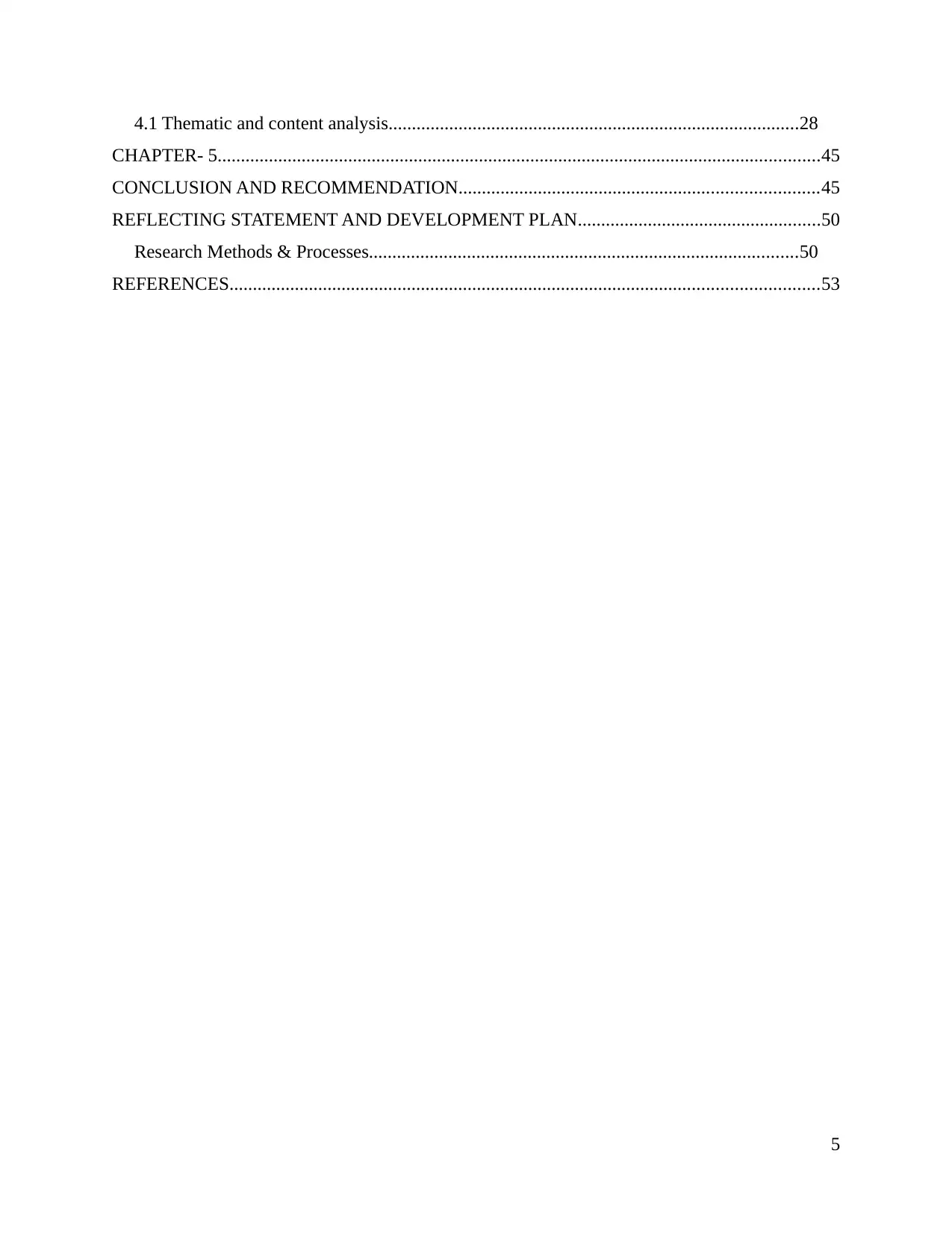
4.1 Thematic and content analysis........................................................................................28
CHAPTER- 5.................................................................................................................................45
CONCLUSION AND RECOMMENDATION.............................................................................45
REFLECTING STATEMENT AND DEVELOPMENT PLAN....................................................50
Research Methods & Processes............................................................................................50
REFERENCES..............................................................................................................................53
5
CHAPTER- 5.................................................................................................................................45
CONCLUSION AND RECOMMENDATION.............................................................................45
REFLECTING STATEMENT AND DEVELOPMENT PLAN....................................................50
Research Methods & Processes............................................................................................50
REFERENCES..............................................................................................................................53
5
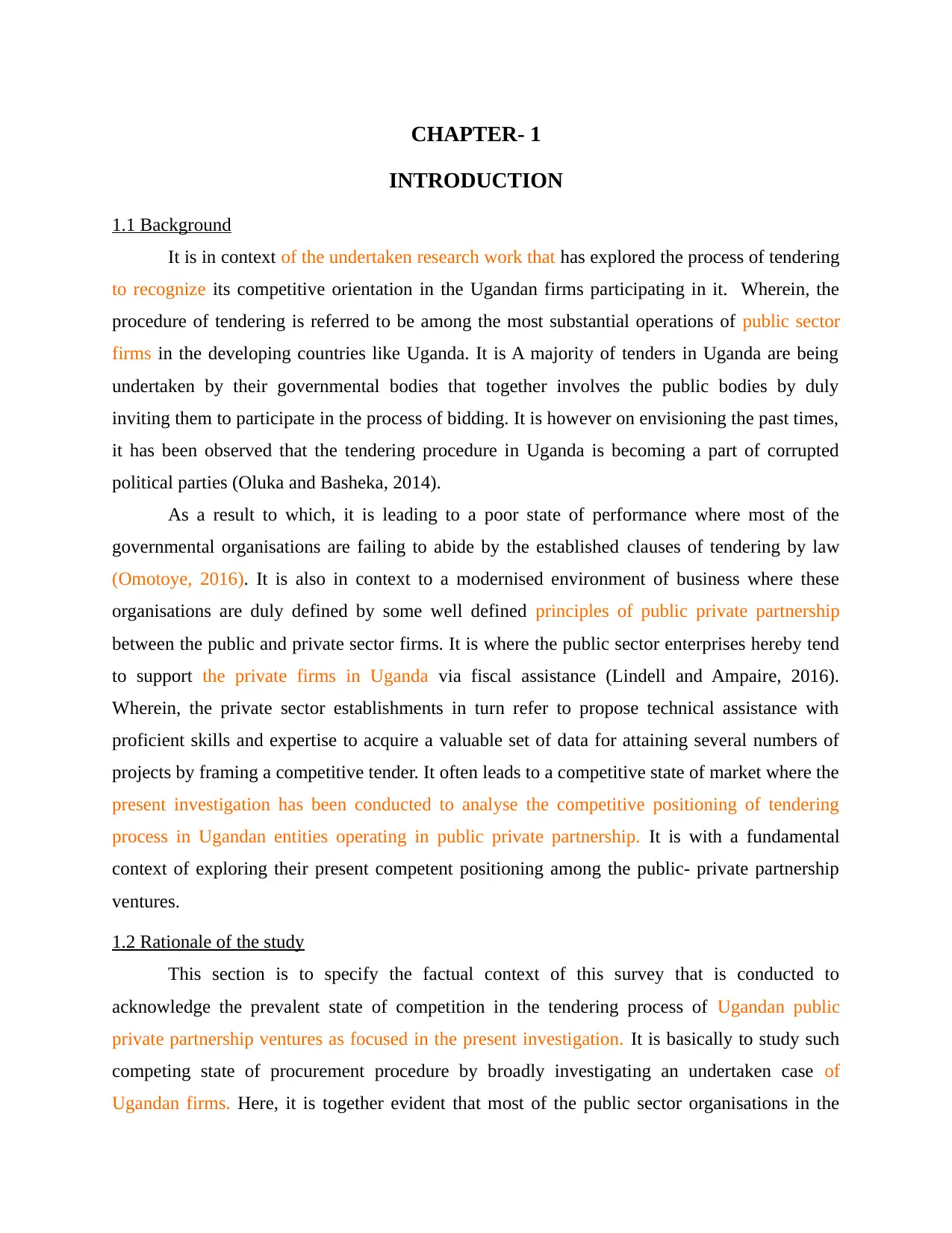
CHAPTER- 1
INTRODUCTION
1.1 Background
It is in context of the undertaken research work that has explored the process of tendering
to recognize its competitive orientation in the Ugandan firms participating in it. Wherein, the
procedure of tendering is referred to be among the most substantial operations of public sector
firms in the developing countries like Uganda. It is A majority of tenders in Uganda are being
undertaken by their governmental bodies that together involves the public bodies by duly
inviting them to participate in the process of bidding. It is however on envisioning the past times,
it has been observed that the tendering procedure in Uganda is becoming a part of corrupted
political parties (Oluka and Basheka, 2014).
As a result to which, it is leading to a poor state of performance where most of the
governmental organisations are failing to abide by the established clauses of tendering by law
(Omotoye, 2016). It is also in context to a modernised environment of business where these
organisations are duly defined by some well defined principles of public private partnership
between the public and private sector firms. It is where the public sector enterprises hereby tend
to support the private firms in Uganda via fiscal assistance (Lindell and Ampaire, 2016).
Wherein, the private sector establishments in turn refer to propose technical assistance with
proficient skills and expertise to acquire a valuable set of data for attaining several numbers of
projects by framing a competitive tender. It often leads to a competitive state of market where the
present investigation has been conducted to analyse the competitive positioning of tendering
process in Ugandan entities operating in public private partnership. It is with a fundamental
context of exploring their present competent positioning among the public- private partnership
ventures.
1.2 Rationale of the study
This section is to specify the factual context of this survey that is conducted to
acknowledge the prevalent state of competition in the tendering process of Ugandan public
private partnership ventures as focused in the present investigation. It is basically to study such
competing state of procurement procedure by broadly investigating an undertaken case of
Ugandan firms. Here, it is together evident that most of the public sector organisations in the
INTRODUCTION
1.1 Background
It is in context of the undertaken research work that has explored the process of tendering
to recognize its competitive orientation in the Ugandan firms participating in it. Wherein, the
procedure of tendering is referred to be among the most substantial operations of public sector
firms in the developing countries like Uganda. It is A majority of tenders in Uganda are being
undertaken by their governmental bodies that together involves the public bodies by duly
inviting them to participate in the process of bidding. It is however on envisioning the past times,
it has been observed that the tendering procedure in Uganda is becoming a part of corrupted
political parties (Oluka and Basheka, 2014).
As a result to which, it is leading to a poor state of performance where most of the
governmental organisations are failing to abide by the established clauses of tendering by law
(Omotoye, 2016). It is also in context to a modernised environment of business where these
organisations are duly defined by some well defined principles of public private partnership
between the public and private sector firms. It is where the public sector enterprises hereby tend
to support the private firms in Uganda via fiscal assistance (Lindell and Ampaire, 2016).
Wherein, the private sector establishments in turn refer to propose technical assistance with
proficient skills and expertise to acquire a valuable set of data for attaining several numbers of
projects by framing a competitive tender. It often leads to a competitive state of market where the
present investigation has been conducted to analyse the competitive positioning of tendering
process in Ugandan entities operating in public private partnership. It is with a fundamental
context of exploring their present competent positioning among the public- private partnership
ventures.
1.2 Rationale of the study
This section is to specify the factual context of this survey that is conducted to
acknowledge the prevalent state of competition in the tendering process of Ugandan public
private partnership ventures as focused in the present investigation. It is basically to study such
competing state of procurement procedure by broadly investigating an undertaken case of
Ugandan firms. Here, it is together evident that most of the public sector organisations in the
⊘ This is a preview!⊘
Do you want full access?
Subscribe today to unlock all pages.

Trusted by 1+ million students worldwide
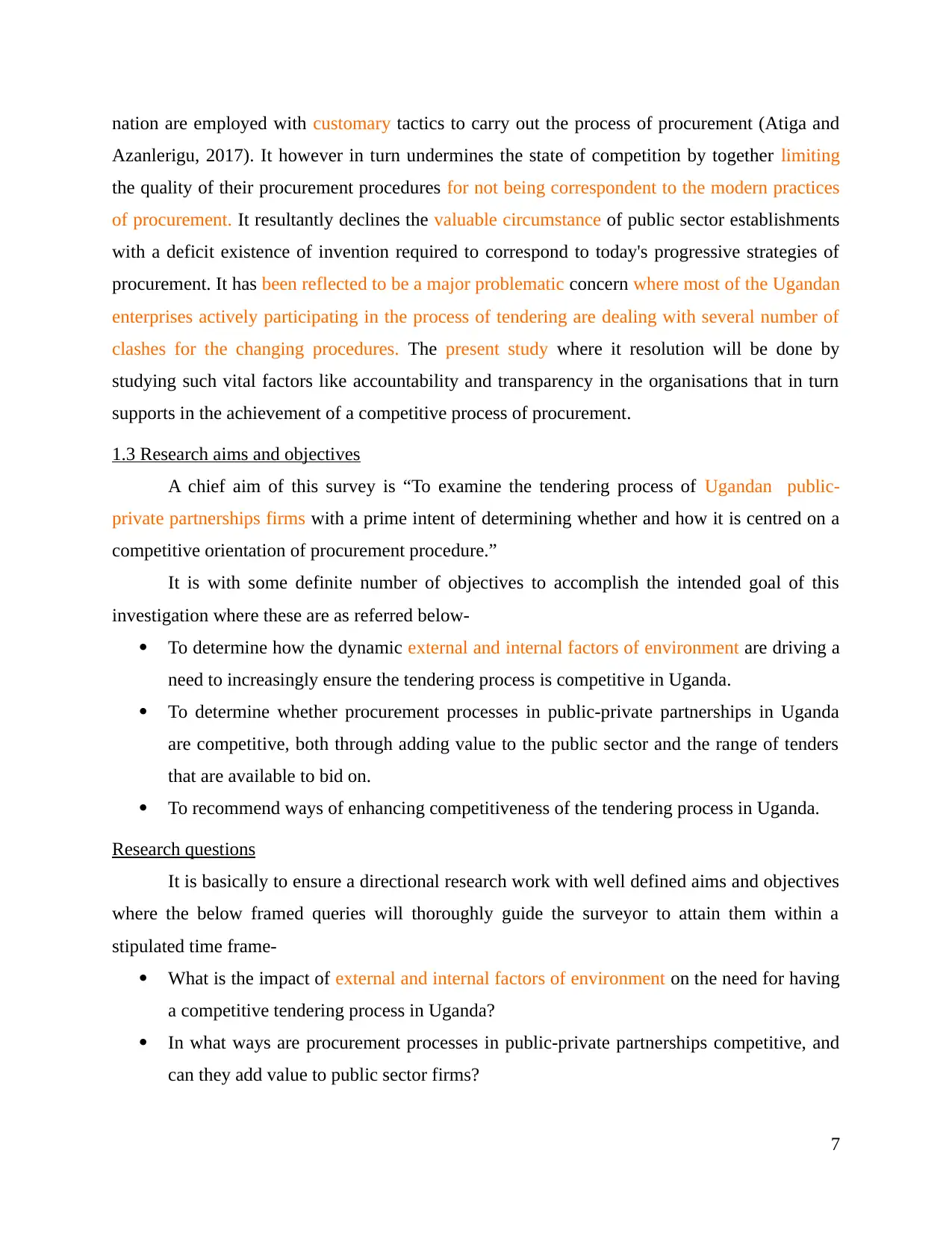
nation are employed with customary tactics to carry out the process of procurement (Atiga and
Azanlerigu, 2017). It however in turn undermines the state of competition by together limiting
the quality of their procurement procedures for not being correspondent to the modern practices
of procurement. It resultantly declines the valuable circumstance of public sector establishments
with a deficit existence of invention required to correspond to today's progressive strategies of
procurement. It has been reflected to be a major problematic concern where most of the Ugandan
enterprises actively participating in the process of tendering are dealing with several number of
clashes for the changing procedures. The present study where it resolution will be done by
studying such vital factors like accountability and transparency in the organisations that in turn
supports in the achievement of a competitive process of procurement.
1.3 Research aims and objectives
A chief aim of this survey is “To examine the tendering process of Ugandan public-
private partnerships firms with a prime intent of determining whether and how it is centred on a
competitive orientation of procurement procedure.”
It is with some definite number of objectives to accomplish the intended goal of this
investigation where these are as referred below-
To determine how the dynamic external and internal factors of environment are driving a
need to increasingly ensure the tendering process is competitive in Uganda.
To determine whether procurement processes in public-private partnerships in Uganda
are competitive, both through adding value to the public sector and the range of tenders
that are available to bid on.
To recommend ways of enhancing competitiveness of the tendering process in Uganda.
Research questions
It is basically to ensure a directional research work with well defined aims and objectives
where the below framed queries will thoroughly guide the surveyor to attain them within a
stipulated time frame-
What is the impact of external and internal factors of environment on the need for having
a competitive tendering process in Uganda?
In what ways are procurement processes in public-private partnerships competitive, and
can they add value to public sector firms?
7
Azanlerigu, 2017). It however in turn undermines the state of competition by together limiting
the quality of their procurement procedures for not being correspondent to the modern practices
of procurement. It resultantly declines the valuable circumstance of public sector establishments
with a deficit existence of invention required to correspond to today's progressive strategies of
procurement. It has been reflected to be a major problematic concern where most of the Ugandan
enterprises actively participating in the process of tendering are dealing with several number of
clashes for the changing procedures. The present study where it resolution will be done by
studying such vital factors like accountability and transparency in the organisations that in turn
supports in the achievement of a competitive process of procurement.
1.3 Research aims and objectives
A chief aim of this survey is “To examine the tendering process of Ugandan public-
private partnerships firms with a prime intent of determining whether and how it is centred on a
competitive orientation of procurement procedure.”
It is with some definite number of objectives to accomplish the intended goal of this
investigation where these are as referred below-
To determine how the dynamic external and internal factors of environment are driving a
need to increasingly ensure the tendering process is competitive in Uganda.
To determine whether procurement processes in public-private partnerships in Uganda
are competitive, both through adding value to the public sector and the range of tenders
that are available to bid on.
To recommend ways of enhancing competitiveness of the tendering process in Uganda.
Research questions
It is basically to ensure a directional research work with well defined aims and objectives
where the below framed queries will thoroughly guide the surveyor to attain them within a
stipulated time frame-
What is the impact of external and internal factors of environment on the need for having
a competitive tendering process in Uganda?
In what ways are procurement processes in public-private partnerships competitive, and
can they add value to public sector firms?
7
Paraphrase This Document
Need a fresh take? Get an instant paraphrase of this document with our AI Paraphraser
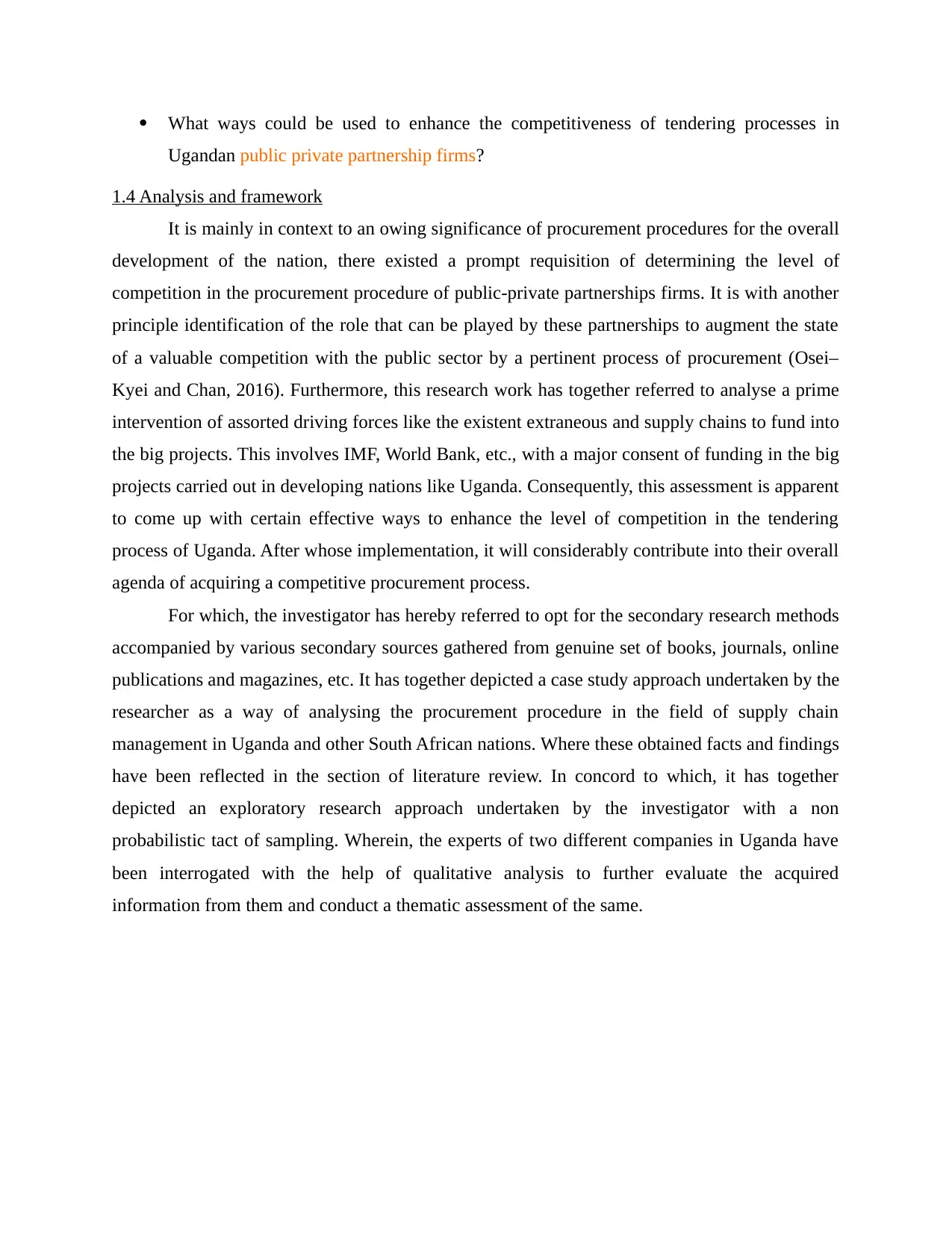
What ways could be used to enhance the competitiveness of tendering processes in
Ugandan public private partnership firms?
1.4 Analysis and framework
It is mainly in context to an owing significance of procurement procedures for the overall
development of the nation, there existed a prompt requisition of determining the level of
competition in the procurement procedure of public-private partnerships firms. It is with another
principle identification of the role that can be played by these partnerships to augment the state
of a valuable competition with the public sector by a pertinent process of procurement (Osei–
Kyei and Chan, 2016). Furthermore, this research work has together referred to analyse a prime
intervention of assorted driving forces like the existent extraneous and supply chains to fund into
the big projects. This involves IMF, World Bank, etc., with a major consent of funding in the big
projects carried out in developing nations like Uganda. Consequently, this assessment is apparent
to come up with certain effective ways to enhance the level of competition in the tendering
process of Uganda. After whose implementation, it will considerably contribute into their overall
agenda of acquiring a competitive procurement process.
For which, the investigator has hereby referred to opt for the secondary research methods
accompanied by various secondary sources gathered from genuine set of books, journals, online
publications and magazines, etc. It has together depicted a case study approach undertaken by the
researcher as a way of analysing the procurement procedure in the field of supply chain
management in Uganda and other South African nations. Where these obtained facts and findings
have been reflected in the section of literature review. In concord to which, it has together
depicted an exploratory research approach undertaken by the investigator with a non
probabilistic tact of sampling. Wherein, the experts of two different companies in Uganda have
been interrogated with the help of qualitative analysis to further evaluate the acquired
information from them and conduct a thematic assessment of the same.
Ugandan public private partnership firms?
1.4 Analysis and framework
It is mainly in context to an owing significance of procurement procedures for the overall
development of the nation, there existed a prompt requisition of determining the level of
competition in the procurement procedure of public-private partnerships firms. It is with another
principle identification of the role that can be played by these partnerships to augment the state
of a valuable competition with the public sector by a pertinent process of procurement (Osei–
Kyei and Chan, 2016). Furthermore, this research work has together referred to analyse a prime
intervention of assorted driving forces like the existent extraneous and supply chains to fund into
the big projects. This involves IMF, World Bank, etc., with a major consent of funding in the big
projects carried out in developing nations like Uganda. Consequently, this assessment is apparent
to come up with certain effective ways to enhance the level of competition in the tendering
process of Uganda. After whose implementation, it will considerably contribute into their overall
agenda of acquiring a competitive procurement process.
For which, the investigator has hereby referred to opt for the secondary research methods
accompanied by various secondary sources gathered from genuine set of books, journals, online
publications and magazines, etc. It has together depicted a case study approach undertaken by the
researcher as a way of analysing the procurement procedure in the field of supply chain
management in Uganda and other South African nations. Where these obtained facts and findings
have been reflected in the section of literature review. In concord to which, it has together
depicted an exploratory research approach undertaken by the investigator with a non
probabilistic tact of sampling. Wherein, the experts of two different companies in Uganda have
been interrogated with the help of qualitative analysis to further evaluate the acquired
information from them and conduct a thematic assessment of the same.
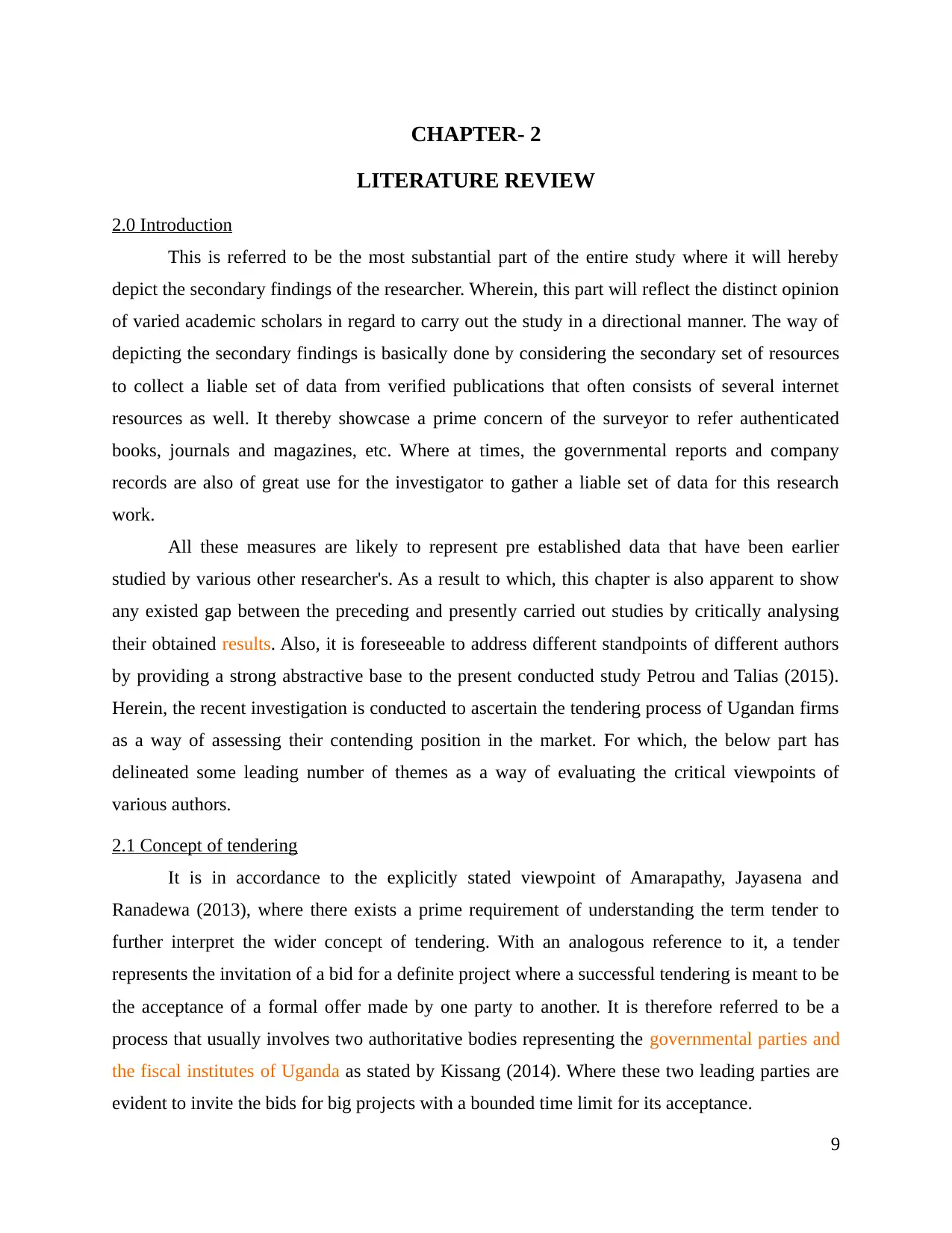
CHAPTER- 2
LITERATURE REVIEW
2.0 Introduction
This is referred to be the most substantial part of the entire study where it will hereby
depict the secondary findings of the researcher. Wherein, this part will reflect the distinct opinion
of varied academic scholars in regard to carry out the study in a directional manner. The way of
depicting the secondary findings is basically done by considering the secondary set of resources
to collect a liable set of data from verified publications that often consists of several internet
resources as well. It thereby showcase a prime concern of the surveyor to refer authenticated
books, journals and magazines, etc. Where at times, the governmental reports and company
records are also of great use for the investigator to gather a liable set of data for this research
work.
All these measures are likely to represent pre established data that have been earlier
studied by various other researcher's. As a result to which, this chapter is also apparent to show
any existed gap between the preceding and presently carried out studies by critically analysing
their obtained results. Also, it is foreseeable to address different standpoints of different authors
by providing a strong abstractive base to the present conducted study Petrou and Talias (2015).
Herein, the recent investigation is conducted to ascertain the tendering process of Ugandan firms
as a way of assessing their contending position in the market. For which, the below part has
delineated some leading number of themes as a way of evaluating the critical viewpoints of
various authors.
2.1 Concept of tendering
It is in accordance to the explicitly stated viewpoint of Amarapathy, Jayasena and
Ranadewa (2013), where there exists a prime requirement of understanding the term tender to
further interpret the wider concept of tendering. With an analogous reference to it, a tender
represents the invitation of a bid for a definite project where a successful tendering is meant to be
the acceptance of a formal offer made by one party to another. It is therefore referred to be a
process that usually involves two authoritative bodies representing the governmental parties and
the fiscal institutes of Uganda as stated by Kissang (2014). Where these two leading parties are
evident to invite the bids for big projects with a bounded time limit for its acceptance.
9
LITERATURE REVIEW
2.0 Introduction
This is referred to be the most substantial part of the entire study where it will hereby
depict the secondary findings of the researcher. Wherein, this part will reflect the distinct opinion
of varied academic scholars in regard to carry out the study in a directional manner. The way of
depicting the secondary findings is basically done by considering the secondary set of resources
to collect a liable set of data from verified publications that often consists of several internet
resources as well. It thereby showcase a prime concern of the surveyor to refer authenticated
books, journals and magazines, etc. Where at times, the governmental reports and company
records are also of great use for the investigator to gather a liable set of data for this research
work.
All these measures are likely to represent pre established data that have been earlier
studied by various other researcher's. As a result to which, this chapter is also apparent to show
any existed gap between the preceding and presently carried out studies by critically analysing
their obtained results. Also, it is foreseeable to address different standpoints of different authors
by providing a strong abstractive base to the present conducted study Petrou and Talias (2015).
Herein, the recent investigation is conducted to ascertain the tendering process of Ugandan firms
as a way of assessing their contending position in the market. For which, the below part has
delineated some leading number of themes as a way of evaluating the critical viewpoints of
various authors.
2.1 Concept of tendering
It is in accordance to the explicitly stated viewpoint of Amarapathy, Jayasena and
Ranadewa (2013), where there exists a prime requirement of understanding the term tender to
further interpret the wider concept of tendering. With an analogous reference to it, a tender
represents the invitation of a bid for a definite project where a successful tendering is meant to be
the acceptance of a formal offer made by one party to another. It is therefore referred to be a
process that usually involves two authoritative bodies representing the governmental parties and
the fiscal institutes of Uganda as stated by Kissang (2014). Where these two leading parties are
evident to invite the bids for big projects with a bounded time limit for its acceptance.
9
⊘ This is a preview!⊘
Do you want full access?
Subscribe today to unlock all pages.

Trusted by 1+ million students worldwide
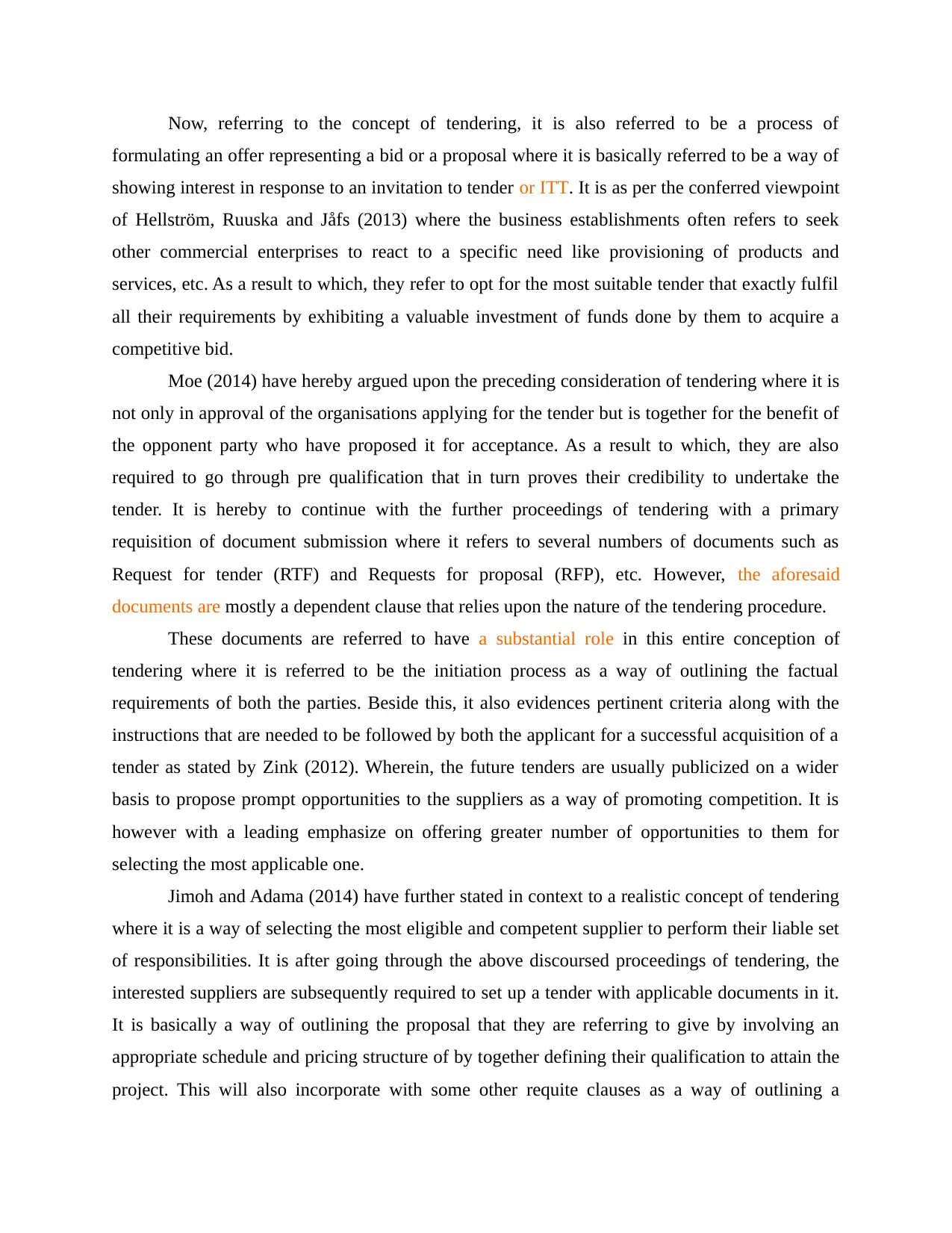
Now, referring to the concept of tendering, it is also referred to be a process of
formulating an offer representing a bid or a proposal where it is basically referred to be a way of
showing interest in response to an invitation to tender or ITT. It is as per the conferred viewpoint
of Hellström, Ruuska and Jåfs (2013) where the business establishments often refers to seek
other commercial enterprises to react to a specific need like provisioning of products and
services, etc. As a result to which, they refer to opt for the most suitable tender that exactly fulfil
all their requirements by exhibiting a valuable investment of funds done by them to acquire a
competitive bid.
Moe (2014) have hereby argued upon the preceding consideration of tendering where it is
not only in approval of the organisations applying for the tender but is together for the benefit of
the opponent party who have proposed it for acceptance. As a result to which, they are also
required to go through pre qualification that in turn proves their credibility to undertake the
tender. It is hereby to continue with the further proceedings of tendering with a primary
requisition of document submission where it refers to several numbers of documents such as
Request for tender (RTF) and Requests for proposal (RFP), etc. However, the aforesaid
documents are mostly a dependent clause that relies upon the nature of the tendering procedure.
These documents are referred to have a substantial role in this entire conception of
tendering where it is referred to be the initiation process as a way of outlining the factual
requirements of both the parties. Beside this, it also evidences pertinent criteria along with the
instructions that are needed to be followed by both the applicant for a successful acquisition of a
tender as stated by Zink (2012). Wherein, the future tenders are usually publicized on a wider
basis to propose prompt opportunities to the suppliers as a way of promoting competition. It is
however with a leading emphasize on offering greater number of opportunities to them for
selecting the most applicable one.
Jimoh and Adama (2014) have further stated in context to a realistic concept of tendering
where it is a way of selecting the most eligible and competent supplier to perform their liable set
of responsibilities. It is after going through the above discoursed proceedings of tendering, the
interested suppliers are subsequently required to set up a tender with applicable documents in it.
It is basically a way of outlining the proposal that they are referring to give by involving an
appropriate schedule and pricing structure of by together defining their qualification to attain the
project. This will also incorporate with some other requite clauses as a way of outlining a
formulating an offer representing a bid or a proposal where it is basically referred to be a way of
showing interest in response to an invitation to tender or ITT. It is as per the conferred viewpoint
of Hellström, Ruuska and Jåfs (2013) where the business establishments often refers to seek
other commercial enterprises to react to a specific need like provisioning of products and
services, etc. As a result to which, they refer to opt for the most suitable tender that exactly fulfil
all their requirements by exhibiting a valuable investment of funds done by them to acquire a
competitive bid.
Moe (2014) have hereby argued upon the preceding consideration of tendering where it is
not only in approval of the organisations applying for the tender but is together for the benefit of
the opponent party who have proposed it for acceptance. As a result to which, they are also
required to go through pre qualification that in turn proves their credibility to undertake the
tender. It is hereby to continue with the further proceedings of tendering with a primary
requisition of document submission where it refers to several numbers of documents such as
Request for tender (RTF) and Requests for proposal (RFP), etc. However, the aforesaid
documents are mostly a dependent clause that relies upon the nature of the tendering procedure.
These documents are referred to have a substantial role in this entire conception of
tendering where it is referred to be the initiation process as a way of outlining the factual
requirements of both the parties. Beside this, it also evidences pertinent criteria along with the
instructions that are needed to be followed by both the applicant for a successful acquisition of a
tender as stated by Zink (2012). Wherein, the future tenders are usually publicized on a wider
basis to propose prompt opportunities to the suppliers as a way of promoting competition. It is
however with a leading emphasize on offering greater number of opportunities to them for
selecting the most applicable one.
Jimoh and Adama (2014) have further stated in context to a realistic concept of tendering
where it is a way of selecting the most eligible and competent supplier to perform their liable set
of responsibilities. It is after going through the above discoursed proceedings of tendering, the
interested suppliers are subsequently required to set up a tender with applicable documents in it.
It is basically a way of outlining the proposal that they are referring to give by involving an
appropriate schedule and pricing structure of by together defining their qualification to attain the
project. This will also incorporate with some other requite clauses as a way of outlining a
Paraphrase This Document
Need a fresh take? Get an instant paraphrase of this document with our AI Paraphraser
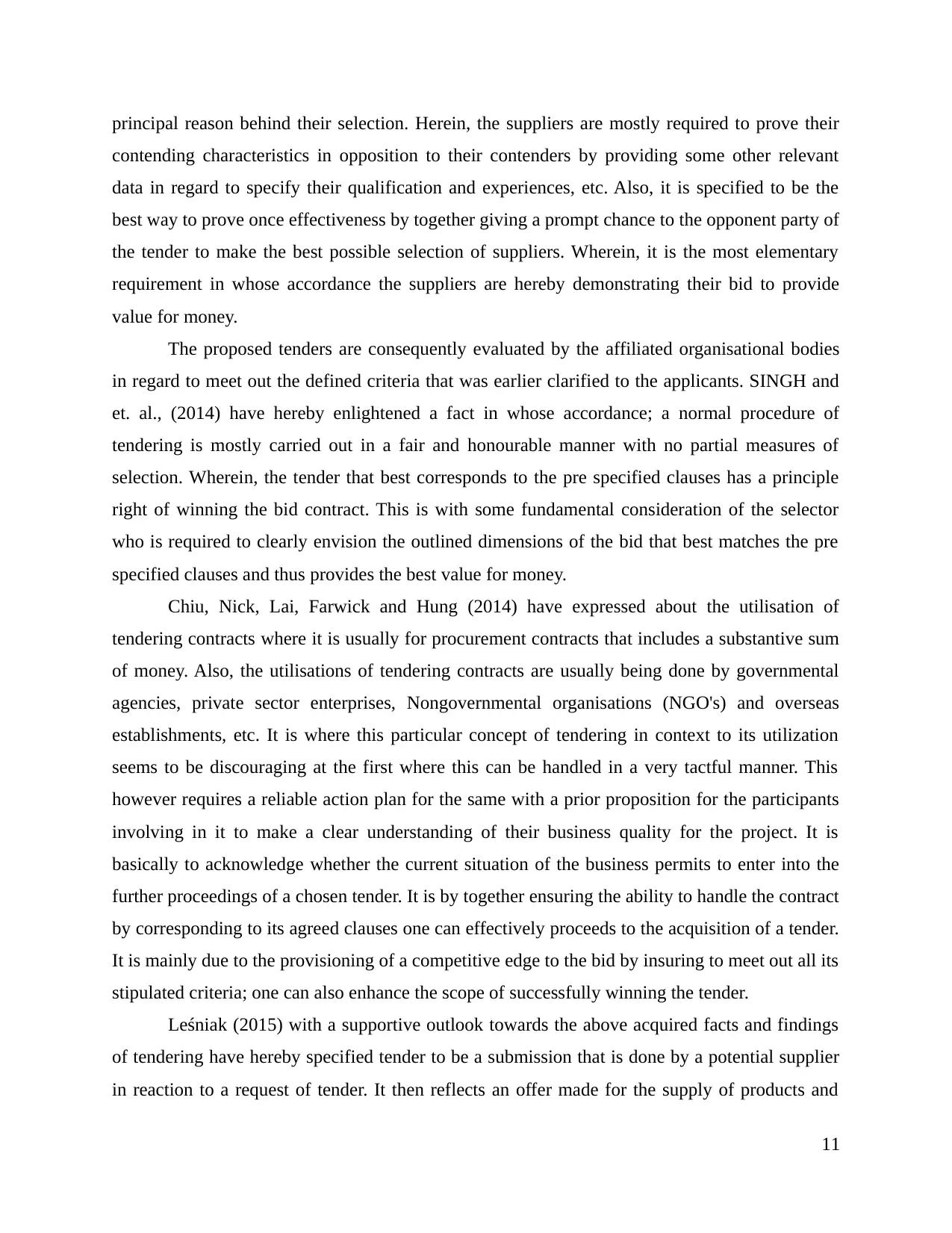
principal reason behind their selection. Herein, the suppliers are mostly required to prove their
contending characteristics in opposition to their contenders by providing some other relevant
data in regard to specify their qualification and experiences, etc. Also, it is specified to be the
best way to prove once effectiveness by together giving a prompt chance to the opponent party of
the tender to make the best possible selection of suppliers. Wherein, it is the most elementary
requirement in whose accordance the suppliers are hereby demonstrating their bid to provide
value for money.
The proposed tenders are consequently evaluated by the affiliated organisational bodies
in regard to meet out the defined criteria that was earlier clarified to the applicants. SINGH and
et. al., (2014) have hereby enlightened a fact in whose accordance; a normal procedure of
tendering is mostly carried out in a fair and honourable manner with no partial measures of
selection. Wherein, the tender that best corresponds to the pre specified clauses has a principle
right of winning the bid contract. This is with some fundamental consideration of the selector
who is required to clearly envision the outlined dimensions of the bid that best matches the pre
specified clauses and thus provides the best value for money.
Chiu, Nick, Lai, Farwick and Hung (2014) have expressed about the utilisation of
tendering contracts where it is usually for procurement contracts that includes a substantive sum
of money. Also, the utilisations of tendering contracts are usually being done by governmental
agencies, private sector enterprises, Nongovernmental organisations (NGO's) and overseas
establishments, etc. It is where this particular concept of tendering in context to its utilization
seems to be discouraging at the first where this can be handled in a very tactful manner. This
however requires a reliable action plan for the same with a prior proposition for the participants
involving in it to make a clear understanding of their business quality for the project. It is
basically to acknowledge whether the current situation of the business permits to enter into the
further proceedings of a chosen tender. It is by together ensuring the ability to handle the contract
by corresponding to its agreed clauses one can effectively proceeds to the acquisition of a tender.
It is mainly due to the provisioning of a competitive edge to the bid by insuring to meet out all its
stipulated criteria; one can also enhance the scope of successfully winning the tender.
Leśniak (2015) with a supportive outlook towards the above acquired facts and findings
of tendering have hereby specified tender to be a submission that is done by a potential supplier
in reaction to a request of tender. It then reflects an offer made for the supply of products and
11
contending characteristics in opposition to their contenders by providing some other relevant
data in regard to specify their qualification and experiences, etc. Also, it is specified to be the
best way to prove once effectiveness by together giving a prompt chance to the opponent party of
the tender to make the best possible selection of suppliers. Wherein, it is the most elementary
requirement in whose accordance the suppliers are hereby demonstrating their bid to provide
value for money.
The proposed tenders are consequently evaluated by the affiliated organisational bodies
in regard to meet out the defined criteria that was earlier clarified to the applicants. SINGH and
et. al., (2014) have hereby enlightened a fact in whose accordance; a normal procedure of
tendering is mostly carried out in a fair and honourable manner with no partial measures of
selection. Wherein, the tender that best corresponds to the pre specified clauses has a principle
right of winning the bid contract. This is with some fundamental consideration of the selector
who is required to clearly envision the outlined dimensions of the bid that best matches the pre
specified clauses and thus provides the best value for money.
Chiu, Nick, Lai, Farwick and Hung (2014) have expressed about the utilisation of
tendering contracts where it is usually for procurement contracts that includes a substantive sum
of money. Also, the utilisations of tendering contracts are usually being done by governmental
agencies, private sector enterprises, Nongovernmental organisations (NGO's) and overseas
establishments, etc. It is where this particular concept of tendering in context to its utilization
seems to be discouraging at the first where this can be handled in a very tactful manner. This
however requires a reliable action plan for the same with a prior proposition for the participants
involving in it to make a clear understanding of their business quality for the project. It is
basically to acknowledge whether the current situation of the business permits to enter into the
further proceedings of a chosen tender. It is by together ensuring the ability to handle the contract
by corresponding to its agreed clauses one can effectively proceeds to the acquisition of a tender.
It is mainly due to the provisioning of a competitive edge to the bid by insuring to meet out all its
stipulated criteria; one can also enhance the scope of successfully winning the tender.
Leśniak (2015) with a supportive outlook towards the above acquired facts and findings
of tendering have hereby specified tender to be a submission that is done by a potential supplier
in reaction to a request of tender. It then reflects an offer made for the supply of products and
11
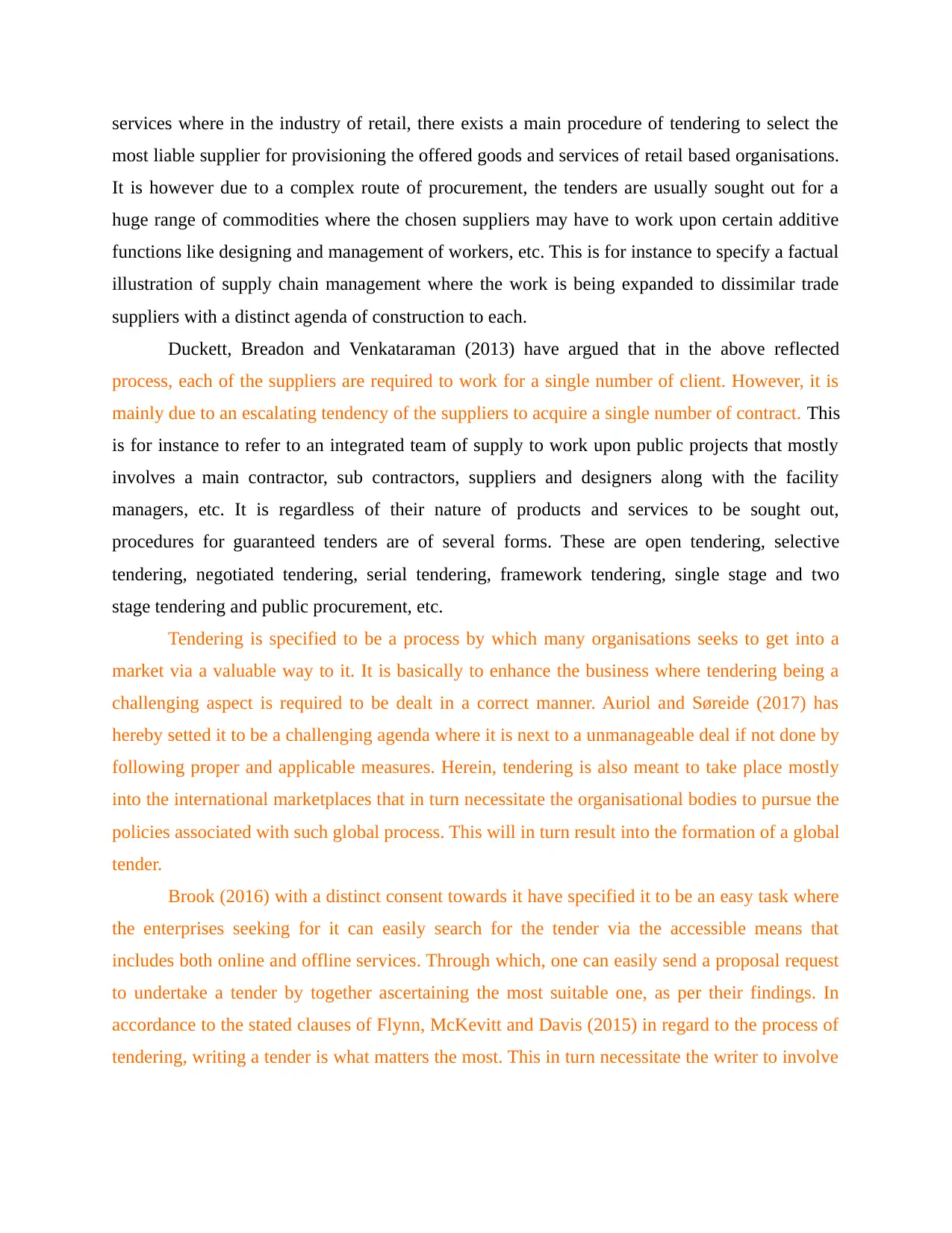
services where in the industry of retail, there exists a main procedure of tendering to select the
most liable supplier for provisioning the offered goods and services of retail based organisations.
It is however due to a complex route of procurement, the tenders are usually sought out for a
huge range of commodities where the chosen suppliers may have to work upon certain additive
functions like designing and management of workers, etc. This is for instance to specify a factual
illustration of supply chain management where the work is being expanded to dissimilar trade
suppliers with a distinct agenda of construction to each.
Duckett, Breadon and Venkataraman (2013) have argued that in the above reflected
process, each of the suppliers are required to work for a single number of client. However, it is
mainly due to an escalating tendency of the suppliers to acquire a single number of contract. This
is for instance to refer to an integrated team of supply to work upon public projects that mostly
involves a main contractor, sub contractors, suppliers and designers along with the facility
managers, etc. It is regardless of their nature of products and services to be sought out,
procedures for guaranteed tenders are of several forms. These are open tendering, selective
tendering, negotiated tendering, serial tendering, framework tendering, single stage and two
stage tendering and public procurement, etc.
Tendering is specified to be a process by which many organisations seeks to get into a
market via a valuable way to it. It is basically to enhance the business where tendering being a
challenging aspect is required to be dealt in a correct manner. Auriol and Søreide (2017) has
hereby setted it to be a challenging agenda where it is next to a unmanageable deal if not done by
following proper and applicable measures. Herein, tendering is also meant to take place mostly
into the international marketplaces that in turn necessitate the organisational bodies to pursue the
policies associated with such global process. This will in turn result into the formation of a global
tender.
Brook (2016) with a distinct consent towards it have specified it to be an easy task where
the enterprises seeking for it can easily search for the tender via the accessible means that
includes both online and offline services. Through which, one can easily send a proposal request
to undertake a tender by together ascertaining the most suitable one, as per their findings. In
accordance to the stated clauses of Flynn, McKevitt and Davis (2015) in regard to the process of
tendering, writing a tender is what matters the most. This in turn necessitate the writer to involve
most liable supplier for provisioning the offered goods and services of retail based organisations.
It is however due to a complex route of procurement, the tenders are usually sought out for a
huge range of commodities where the chosen suppliers may have to work upon certain additive
functions like designing and management of workers, etc. This is for instance to specify a factual
illustration of supply chain management where the work is being expanded to dissimilar trade
suppliers with a distinct agenda of construction to each.
Duckett, Breadon and Venkataraman (2013) have argued that in the above reflected
process, each of the suppliers are required to work for a single number of client. However, it is
mainly due to an escalating tendency of the suppliers to acquire a single number of contract. This
is for instance to refer to an integrated team of supply to work upon public projects that mostly
involves a main contractor, sub contractors, suppliers and designers along with the facility
managers, etc. It is regardless of their nature of products and services to be sought out,
procedures for guaranteed tenders are of several forms. These are open tendering, selective
tendering, negotiated tendering, serial tendering, framework tendering, single stage and two
stage tendering and public procurement, etc.
Tendering is specified to be a process by which many organisations seeks to get into a
market via a valuable way to it. It is basically to enhance the business where tendering being a
challenging aspect is required to be dealt in a correct manner. Auriol and Søreide (2017) has
hereby setted it to be a challenging agenda where it is next to a unmanageable deal if not done by
following proper and applicable measures. Herein, tendering is also meant to take place mostly
into the international marketplaces that in turn necessitate the organisational bodies to pursue the
policies associated with such global process. This will in turn result into the formation of a global
tender.
Brook (2016) with a distinct consent towards it have specified it to be an easy task where
the enterprises seeking for it can easily search for the tender via the accessible means that
includes both online and offline services. Through which, one can easily send a proposal request
to undertake a tender by together ascertaining the most suitable one, as per their findings. In
accordance to the stated clauses of Flynn, McKevitt and Davis (2015) in regard to the process of
tendering, writing a tender is what matters the most. This in turn necessitate the writer to involve
⊘ This is a preview!⊘
Do you want full access?
Subscribe today to unlock all pages.

Trusted by 1+ million students worldwide
1 out of 59